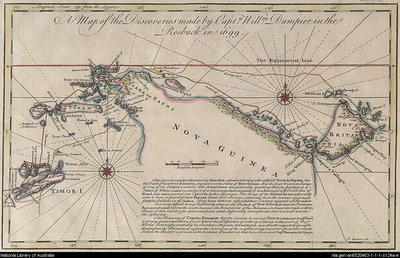William Dampier
|
|
William Dampier (1652 – March, 1715) was a English explorer, sea captain, and scientific observer. He was the first Englishman to explore or map parts of New Holland (Australia) and New Guinea. He was the first person to circumnavigate the world twice, and went on to complete a third circumnavigation.
Dampier was born at East Coker in Somerset and went to sea at the age of 16. He served with Edward Sprague in the Third Anglo-Dutch War and fought at the Battle of Schooneveld in June 1673. In 1674 he worked as a plantation manager on Jamaica, but he soon returned to the sea,
| Contents |
First circumnavigation
In the 1670s he crewed with buccaneers on the Spanish Main of Central America, twice visiting the Bay of Campeachy. This led to his first circumnavigation: in 1679 he accompanied a raid across the [[Dari鮠Province|Isthmus of Dari鮝] in Panama and captured Spanish ships on the Pacific coast of that isthmus; the pirates then raided Spanish settlements in Peru before returning to the Caribbean.
Dampier made his way to Virginia, where in 1683 he engaged with a privateer named Cook. Cook entered the Pacific via Cape Horn and spent a year raiding Spanish possessions in Peru, the Galapagos Islands, and Mexico. This expedition collected buccaneers and ships as it went along, at one time having a fleet of ten vessels. In Mexico Cook died, and a new leader, Captain Davis, took command. Dampier transferred to Captain Swan's ship, the Cygnet, and on 31 March 1686 they set out across the Pacific to raid the East Indies, calling at Guam and Mindanao. Leaving Swan and 36 others behind, the rest of the pirates cruised to Manila, Pulo Condore, China, the Spice Islands, and New Holland (Australia).
Early in 1688 Cygnet was beached on the northwest coast of Australia, near King Sound. While the ship was being careened Dampier made notes on the fauna and flora he found there. Later that year, by agreement, he and two shipmates were marooned on one of the Nicobar Islands. They built a small craft and sailed it to Acheen in Sumatra. After further adventures Dampier returned to England in 1691 via the Cape of Good Hope, penniless but in possession of his journals.
The Roebuck expedition

The publication of these journals as New Voyage Round the World in 1697 created interest at the British Admiralty and in 1699 Dampier was given the command of HMS Roebuck with a commission to explore Australia and New Guinea.
The expedition set out on 14 January 1699, and on July 1699 he reached Dirk Hartog Island at the mouth of Shark Bay in Western Australia. In search of water he followed the coast northeast, reaching the Dampier Archipelago and then Roebuck Bay, but finding none he was forced to bear away north for Timor. Then he sailed east and on 1 January 1700 sighted New Guinea, which he passed to the north. Sailing east, he traced the southeastern coasts of New Hanover, New Ireland and New Britain, discovering the Dampier Strait between these islands (now the Bismarck Islands) and New Guinea.
On the return voyage to England, Roebuck foundered near Ascension Island on 21 February 1701 and the crew were marooned there for five weeks before being picked up on 3 April by an East Indiaman and returned home in August 1701.
Although many papers were lost with the Roebuck, Dampier was able to save many new charts of coastlines, trade winds and currents in the seas around Australia and New Guinea.
On his return Dampier was court-martialled for cruelty. On the outward voyage Dampier had crewman George Fisher removed from the ship and jailed in Brazil. Fisher returned to England and complained about his treatment to the Admirality. Dampier wrote an angry vindication of his conduct, but he was found guilty, docked his pay for the voyage, and dismissed from the Royal Navy.
Second circumnavigation
He wrote an account of the 1699–1701 expedition, A Voyage to New Holland and returned to privateering.
In 1703 he was given command of two government ships, Saint George (126 men) and Cinque Ports (63 men) for another expedition to the South Seas.
This voyage was not a success. It is most notable for the events surrounding Alexander Selkirk, the sailing master of Cinque Ports. In October 1704 the expedition had stopped at the uninhabietd Juan Fernandez islands to resupply. Selkirk had grave concerns about the seaworthiness of Cinque Ports, and after a disagreement with Dampier, he opted to remain on the island. Selkirk's misgivings were fully justified: Cinque Ports did sink with the loss of most of her crew. Selkirk was marooned for five years.
Dampier returned to England in 1707 and in 1709 his A Continuation of a Voyage to New Holland was published.
Third circumnavigation
Dampier was engaged in 1708 by the privateer Woodes Rogers as sailing master on the Duke. This voyage was more successful: Selkirk was rescued on 2 February 1709, and the expedition amassed nearly £s;200,000 of profit. However, Dampier died in London in 1715 before he received his share.
Influence
He had an unusual degree of influence on figures better known than he:
- His observations and analysis of natural history helped Charles Darwin's and Alexander von Humboldt's development of their theories,
- He made innovations in navigational technology that were studied by James Cook and Horatio Nelson.
- Daniel Defoe, author of Robinson Crusoe, was inspired by accounts of real-life castaway Alexander Selkirk, a crew-member on Dampier's voyages.
- His reports on breadfruit led to William Bligh's ill-fated voyage in HMS Bounty.
- He is cited over a thousand times in the Oxford English Dictionary.
Works
- A New Voyage Round the World, (1697)
- Voyages and Descriptions, (1699)
- A Supplement of the Voyage Round the World
- The Campeachy Voyages
- A Discourse of Winds
- A Voyage to New Holland, (Part 1 1703, Part 2 1709)
Further reading
- Diana and Michael Preston, A Pirate of Exquisite Mind
- Anton Gill, Devil's Mariner
- Woodes Rogers, Cruising Voyage Round the World, 1712.
External links
- A Voyage to New Holland (http://www.gutenberg.org/etext/15675), by William Dampier, from Project Gutenberg.
- A Continuation of a Voyage to New Holland (http://www.gutenberg.org/etext/15685), by William Dampier.
- William Dampier (http://www.nndb.com/people/943/000096655/) from the Notable Names Database (http://www.nndb.com/)

